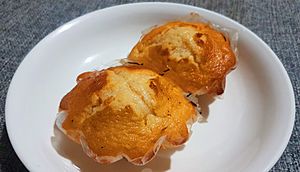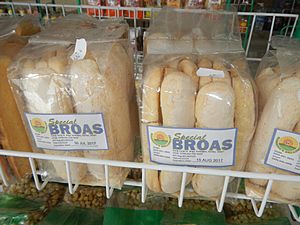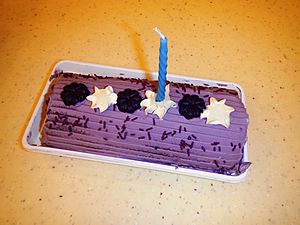Mamón facts for kids

Custard mamón, with a leche flan base
|
|
| Alternative names | torta, torta mamón, torta Visaya, torta Bisaya |
|---|---|
| Course | Dessert |
| Place of origin | Philippines |
| Main ingredients | cake flour, sugar, baking powder, eggs, oil, butter, cream of tartar |
| Variations | mamón tostado, puto mamón, taisan, broas |
Mamón are yummy, soft cakes from the Philippines. They are a type of chiffon or sponge cake, which means they are very light and airy. You'll often see them baked in special cupcake-like molds. In some parts of the Philippines, especially the Visayas regions, people call them torta mamón or just torta.
There are also different kinds of mamón. For example, there's a bigger, loaf-shaped one called taisan, a rolled-up one called pianono, and even ladyfingers called broas. Some mamón are crunchy like cookies, called mamón tostado, and others are steamed, called puto mamón.
Contents
What is Mamón?

Mamón is famous for being super soft and fluffy. It's a light cake, almost like a cloud! It's usually baked in special tin molds that give it a unique cupcake-like shape.
After baking, mamón is often covered with butter. Then, it's sprinkled with white sugar and grated cheese. People commonly eat mamón during merienda, which is like a snack time in the afternoon.
In the Visayas regions, mamón has other names like torta mamón or torta Visaya. The word torta comes from a Spanish word for "cake." Visayan torta is usually a bit thicker and richer. It was traditionally made with lard and a special palm wine called tubâ to help it rise.
Different Kinds of Mamón
There are several tasty variations of mamón. Each one has its own special look and texture.
Broas: Ladyfinger Cookies

The ladyfinger version of mamón is known as broas. The name broas comes from a Portuguese word for a type of bread.
Broas can be soft and spongy, or they can be crunchy like a cookie. People often enjoy them with coffee or hot chocolate. They are also used to make delicious icebox cakes in the Philippines, like crema de fruta and mango float.
Some Filipino groups also have their own broa variations. These can be soft or crunchy and are often eaten during special celebrations like Hari Raya. Other similar crunchy cookies include camachile cookies and lengua de gato cookies.
Mamón Tostado: Toasted Mamón
Mamón tostado is a crunchy, cookie-like version of mamón. The word tostado means "toasted" in Spanish. It uses the same ingredients as regular mamón and is also very airy. However, it's baked longer until it becomes dry and crispy.
Pianono: Rolled Cake

Pianono is a rolled-up version of mamón. Today, it's often sold as "cake rolls" because it looks like a Swiss roll.
Originally, pianono was smaller. It was filled simply with sugar and butter. Modern versions are bigger and can have many different fillings. They are often frosted on the outside too.
Puto Mamón: Steamed Cake
Puto mamón is a type of puto, which is a steamed cake. This means it's cooked using steam instead of being baked in an oven.
Taisan: Loaf-shaped Mamón
Taisan is a larger, loaf-shaped version of mamón. Just like regular mamón, it's usually covered with butter and sprinkled with sugar and cheese. Taisan was first made in Pampanga, a province in the Philippines. Its name means "whetstone" in the Kapampangan language, because of its shape.
Mamón in Filipino Sayings
In Filipino sayings, pusong mamón literally means "mamón-hearted." This phrase describes someone who is very sensitive or easily emotional. It's similar to saying someone is "softhearted" in English.


